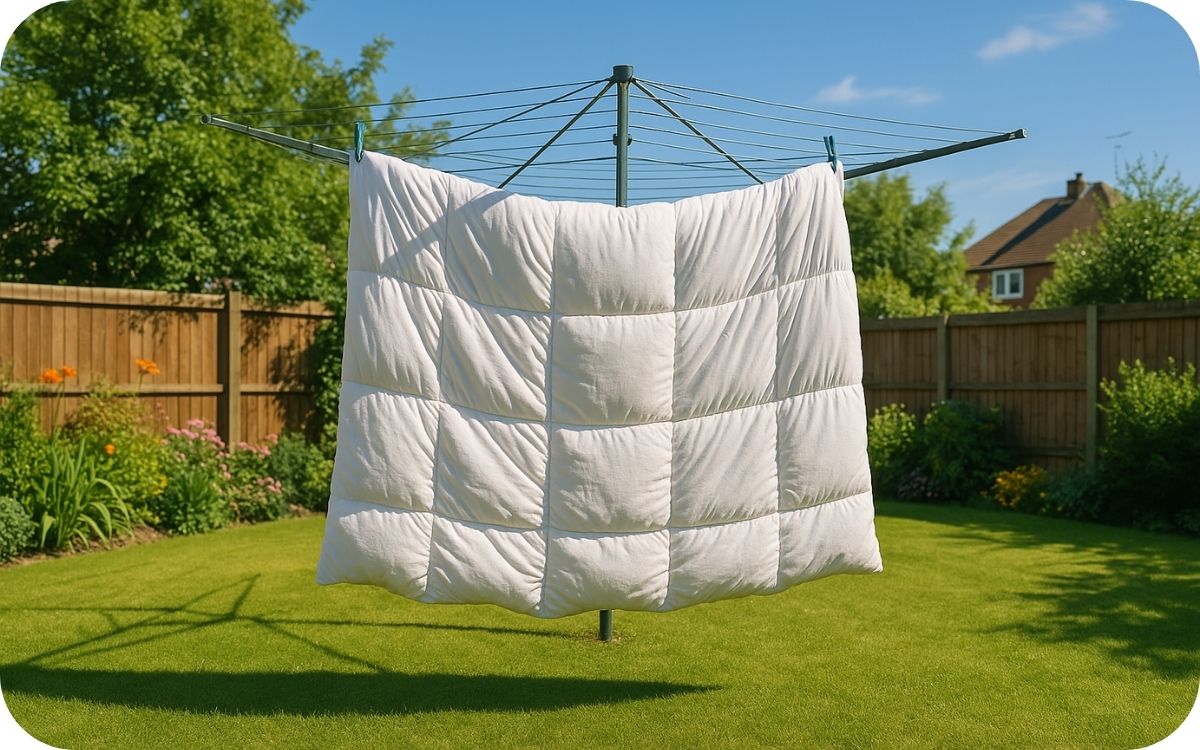Should You Wash Coverless Duvets?
Coverless duvets – sometimes marketed as “all‑in‑one” or “no cover” duvets – promise hotel‑style simplicity: no wrestling with a separate cover on laundry day, just one lightweight layer to pop straight on the bed. But when it comes to hygiene, dust mites and the occasional coffee spill, many sleepers ask the same question: should you wash a coverless duvet, and how on earth do you fit it in the machine?
Below, we at MyBedFrames will walk you through everything you need to know – from manufacturer care labels to eco‑friendly washing hacks – so you can enjoy fresh, fluffy comfort night after night.
What Exactly Is a Coverless Duvet?

How it Differs from a Traditional Duvet & Cover
A traditional duvet consists of two parts:
- Duvet insert – the filled blanket (synthetic or natural fibres).
- Duvet cover – a removable, washable outer layer.
A coverless duvet combines these two into a single sewn‑through piece. The fabric shell is usually printed or dyed so it doubles as the “cover”, eliminating the need to change covers every week.
Key Pros & Cons of Going Coverless
|
Pros |
Cons |
|
Quicker bed‑making – ideal for kids’ rooms and guest beds |
Entire duvet must be washed, even for small stains |
|
Lightweight & often cheaper than buying insert + covers |
Bulkier load may exceed home washing machine capacity |
|
No fiddly buttons or poppers |
Limited design flexibility – you can’t just switch covers |
Can You Wash Coverless Duvets? (The Short Answer)
Yes – most coverless duvets sold in the UK are machine‑washable. The official answer, however, lives on the care label. This small stitched‑in tab tells you:
- Maximum water temperature (°C)
- Recommended cycle (delicate, cotton, synthetics)
- Whether tumble‑drying is permitted
If your label shows a circle with a cross (✖) through the washing‑machine icon, professional cleaning is advised. For the vast majority made with hollowfibre or microfibre filling, a standard 40 °C cycle is perfectly safe.
Why Washing Matters
- Dust mites & allergens – mites thrive in warm, humid bedding and can trigger asthma.
- Body oils & sweat – over time these break down fibres, leading to flat spots and odours.
- Stains – spills set permanently if left untreated.
Regular washing not only keeps things hygienic but also maintains loft, so your duvet stays plump and insulating.
How Often Should You Wash One?
|
Sleeper Type |
Recommended Frequency |
|
Adults (daily use) |
Every 2–3 months |
|
Children |
Every 4–6 weeks (accidents & crumbs are common) |
|
Allergy sufferers |
Monthly, or use a protective cover in between |
|
Guest beds |
After each guest or every 6 months |
Top tip: Rotate between two coverless duvets per bed. While one is drying, the spare can be in use – no bedtime panic.
Seasonal factors also matter. During hot UK summers, extra perspiration may warrant monthly washes, whereas winter duvets can often stretch to 3 months.
Pre‑Wash Preparation
- Check the filling. Synthetic fibres (hollowfibre/microfibre) cope well with machine agitation. Natural fillings (wool, silk) need gentler cycles or specialist cleaning.
- Inspect for damage. Small tears can expand in the drum; sew them shut before washing.
- Treat stains early. Dab mild detergent or a bicarbonate‑soda paste on marks, leave for 15 minutes, then rinse.
- Loosen compacted fibres. Give the duvet a vigorous shake to redistribute filling and avoid clumps.
Washing Methods Explained

1. Machine‑Washing at Home
- Capacity check. A double 10.5‑tog coverless duvet typically needs a 9–10 kg drum. If yours is 7 kg or smaller, head to a launderette.
- Select a gentle liquid detergent. Powders can leave residue; non‑bio is kinder to sensitive skin.
- Choose 40 °C synthetics or delicate cycle. Hotter than 60 °C risks shrinkage.
- Add two clean tennis balls (or dryer balls) to prevent bunching.
- Extra rinse. Removes trapped suds for a fluffier finish.
2. Launderette or Commercial Machines
Oversized drums (13 kg+) handle king‑size or high‑tog duvets with ease. Bring your own detergent to avoid harsh industrial formulas.
3. Professional or Dry‑Clean Services
Opt for this if your duvet:
- Contains wool, silk or feather blend
- Carries a “Do Not Wash” symbol
- Is stained with substances that home detergents struggle with (e.g., fake tan, heavy oils)
Detergent, Temperature & Cycle Settings
|
Filling Type |
Best Detergent |
Temperature |
Spin Speed |
|
Hollowfibre / Microfibre |
Non‑bio liquid |
40 °C |
800 rpm |
|
Wool |
Wool‑safe liquid |
30 °C |
600 rpm |
|
Silk |
pH‑neutral silk wash |
30 °C |
400 rpm |
Avoid fabric softener. It coats fibres, trapping moisture and reducing breathability.
Drying Your Coverless Duvet

Tumble‑Drying Safely
- Low heat only (≤60 °C) to prevent melting synthetic fibres.
- Add dryer balls to speed up drying and refluff filling.
- Pause the cycle every 30 minutes to shake and check progress.
Line‑Drying & Air‑Fluffing
UK weather permits? Peg your duvet longways over two parallel lines for balanced weight distribution. If space‑strapped, drape over a sturdy airer near a radiator and turn every few hours.
Restoring Loft
Once bone‑dry, give the duvet a firm flap & snap along the seams. This breaks up any remaining clumps for an even tog.
Alternatives to a Full Wash
- Sunshine refresh: UV light naturally kills bacteria – 2–3 hours on a bright day revives freshness.
- Spot‑clean: Dab mild detergent on the soiled area, rinse with a damp cloth, then blot dry.
- Steam function: Many modern washing machines and garment steamers offer a 20‑minute bacteria‑busting refresh without water.
- Fabric sprays: Look for anti‑bacterial textile sprays approved under UK BS EN 1276 standards.
Long‑Term Care & Storage
- Airing: Hang over a banister weekly to release trapped moisture.
- Protective layers: A lightweight top sheet or flat sheet cuts down how often you need to wash the duvet itself.
- Storage: Between seasons, store in a breathable cotton bag – avoid vacuum compression for natural fillings as it crushes fibres.
- When to Replace: If the filling no longer springs back, or cold patches form, it’s time to invest in a replacement (typically every 3–5 years).
Eco‑Friendly & Energy‑Saving Tips
- Cold‑wash programs (20–30 °C) paired with modern detergents remove light soiling with up to 60 % less energy.
- Wash full loads only – half‑loads waste water and electricity.
- Line‑dry whenever possible – tumble‑dryers are among the most energy‑hungry appliances in UK homes.
- Choose eco‑labelled detergents that are biodegradable and phosphate‑free.
Frequently Asked Questions
Can a coverless duvet fit in a 7 kg washing machine?
A single or small double (4.5 tog) might squeeze in, but doubles, kings and winter weights generally won’t. Over‑stuffing leads to poor rinsing and may damage your appliance.
Will washing alter the tog rating or fluffiness?
Not if you follow the care label and dry thoroughly. Under‑drying leaves clumps that reduce insulation.
How do I dry one quickly in a UK winter?
Use a tumble‑dryer on low heat with dryer balls, then finish on an indoor airer near a dehumidifier or heated airer to extract remaining moisture.
Does washing void the manufacturer’s guarantee?
Guarantees usually require you to follow the stated care instructions. Keep receipts and photograph the care label before first wash as proof of compliance.
Final Thoughts & Key Takeaways
- Yes, you should wash coverless duvets every 2–3 months – more often for kids and allergy sufferers.
- Check capacity. If it won’t freely turn in your washer, use a launderette or professional service.
- Low heat tumble‑dry (or line‑dry) until completely moisture‑free to prevent mould.
- Eco hacks – cold‑wash short cycles and line‑drying save energy and prolong life.




